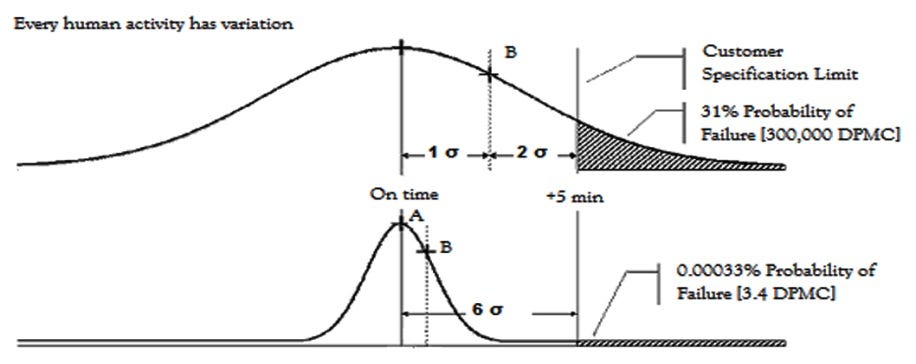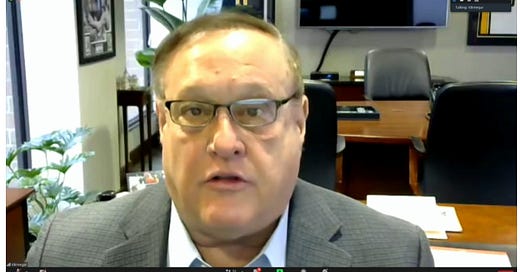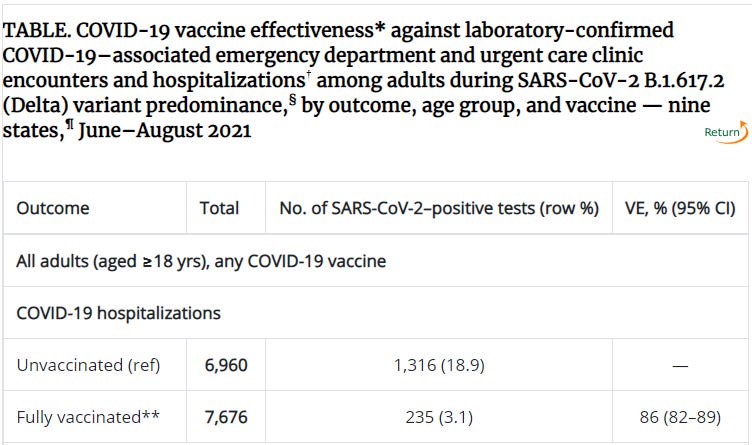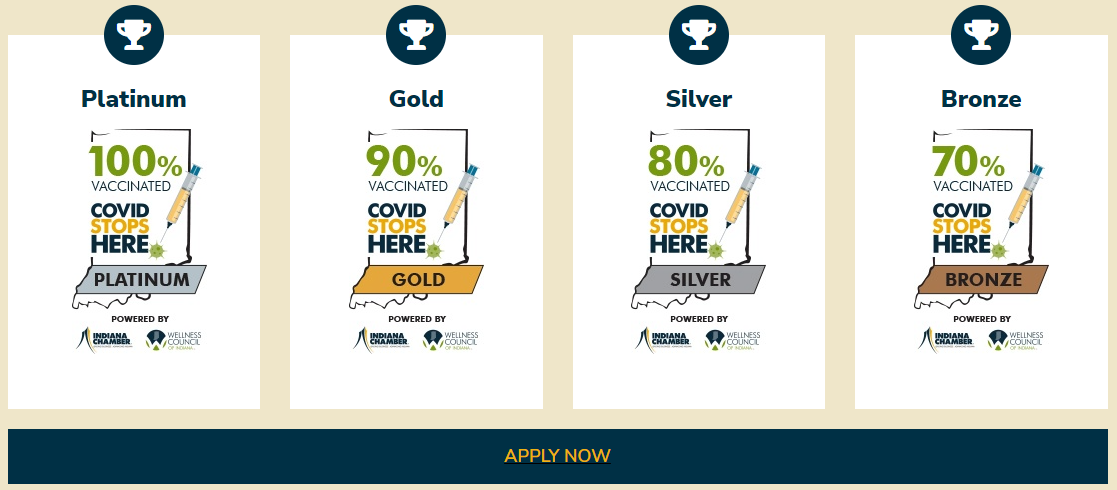A short time ago I was made aware of this interesting news conference/webinar emceed by Kevin Brinegar of the Indiana Chamber of Commerce. The conversation begins with a scary-sounding "state of the hospital system" assessment with decontextualized numbers, spoken with implied significance, that dance over all the important details such as what hospital capacity norms are like, and how much of the problem is actually COVID-19.
The floor is then given to a hospital CEO who claims that 90% of the patients coming in with COVID-19 are unvaccinated. Another hospital executive follows afterward saying that they still find the vaccines 90% effective (I wish that he would share how he computed that) and spends several minutes in a repetitive plea for people to get vaccinated without addressing anything like the points we hear from those who do not want to take the vaccines.
Let's stop here and put a pin in the conversation. Don't worry. We'll come back.
All-Cause Mortality Up 40% for 18-64 Year Olds in Indiana
It is interesting to hear the health insurance execs get to speak only after the hospital execs, and I don't think that's just because I worked my way through college crunching numbers for an insurance company. I'm sure I'm one of many who wonder what kind of diamond mine of data the insurance companies are sitting on, and what it would reveal if we didn't all think they'd face a guillotine-wielding mob for sharing it.
Let me make this clear: it is their duty to humankind to share it. And we need to invite them into the crowd of safety to encourage them to do so, or otherwise twist nipples until it's done. And on that note, if you're a lawyer who can file a FOIA request to find out what the federal government knows about that data, send me an email.
From the news conference, (emphasis mine)
What the data is showing to us is that the deaths that are being reported as COVID deaths greatly understate the actual death losses among working-age people from the pandemic. It may not all be COVID on their death certificate, but deaths are up just huge, huge numbers.
I will now quote this article from Center Square that covered the news conference so that I don't have to transcribe all the important parts myself.
The head of Indianapolis-based insurance company OneAmerica said the death rate is up a stunning 40% from pre-pandemic levels among working-age people.
“We are seeing, right now, the highest death rates we have seen in the history of this business – not just at OneAmerica,” the company’s CEO Scott Davison said during an online news conference this week. “The data is consistent across every player in that business.”
Davison described a 10% increase in mortality as a 3-sigma (standard deviation) event, so that makes 40% a 12-sigma event. That's statistics talk for how far from ordinary unusual events are. For clarification, a three-sigma event should happen around once every 300 or so years and a six-sigma event should happen once every 300,000 or so years. We're talking about the proportion of the area under a normal curve that is shaded in proportion to the total area. We would really need to zoom in on it quite a bit to detect with the naked eye.
A 12-sigma event is where geeky statisticians who have seen enough tables to know the round-numbers by heart have to look up the capacity of their software package to see if it's well enough powered to perform the calculation. Whatever it is, it's far more likely that an asteroid collides with Indiana tomorrow, ejecting 400 basketball-sized fragments as it falls that each make a perfect swoosh through the nets in every cornfield basketball hoop in the Hoosier state two seconds before destroying all of human civilization (really, I computed that in my head).

This is not just about COVID-19, but not one person in the news conference comes out to discuss vaccine deaths or injury, not even to allay the fear. They don't want to discuss it.
Nor did any of them discuss any of the myriad of medicines used by doctors caring for outpatients, including the monoclonal antibodies which now seem to be actively withheld. Or oral/nasal rinsing. Or vitamins.
Mr. Brinegar did wax on a bit about how the "influencers" can coax people into getting vaccinated, and hospital executive Rob McClinn (sp?) urged people not to listen to what people are saying over the internet, but to look at the data. I would like to make an open invitation for Rob to send me what he considers to be the best data and to join me for a recorded conversation about it in case I'm the one spreading misinformation on the internet.
The Chief Endpoint of COVID-like Illness (CLI) is Confusion
Former head of the Arizona Department of Health Services Will Humble had it right when he cautioned about categorization of COVID-like illness in late 2020:
"It’s essentially a soft reporting method of some subjective symptoms that can be observed in hospital and emergency department settings," he said.
Like cough, fever or shortness of breath. But in the early days of COVID: "Testing was so limited that COVID-like illness observations had some value, because it's all we had," Humble explained.
But now testing is widely available and results come fairly fast. Something else: not everyone develops those classic COVID symptoms.
"So, why would you still put weight on something as flimsy as COVID-like illness, which is subjective and poorly reported? So that's the issue that I have is that we're using a metric from the Stone Ages."
That article at KJZZ continues
Saskia Popescu is an epidemiologist at the University of Arizona's College of Public Health.
"So, I think that the challenge is that when we're using COVID-like illness as a surveillance mechanism, it's inherently limited," she said. "And that's really what we're doing in the U.S. with the CDC is they mix it with influenza-like illness so that that data gets pulled together. So they're really using two syndromic surveillance networks to start to see, because we know sometimes the symptoms are similar, If you are starting to see these massive influx of people with a fever, and a cough and difficulty breathing, that is an indication that, sure, it might be seasonal influenza, it might just be normal respiratory viruses, but it also could be COVID-19."
So, while syndromic surveillance provides some information, it doesn't paint a complete picture of what's happening. Still, Popescu says more data is good.
In other words, COVID-like Illness (CLI) borrowed from the principle of identifying flu-like illness as a method of surveillance to get a picture of community health conditions. But there are multiple problems with this relaxed use of terminology, the first being that COVID-19 is a disease. And diseases are defined by symptoms. And while this informal system of surveillance may seem harmless, it makes a big difference.
Could all those non-COVID deaths be death from CLI? Could the CLI be vaccine-associated?
Let's take a look at a recent student on the CDC's website: Grannis et al, 2021.
For the moment, we ignore the conclusions of the authors who did nothing to estimate any adjustments for survivorship bias or selection bias, and look at their own data. Let us also note that this study excludes everyone between their first injection through 14 days after their second, which includes a whole lot of people with serious adverse events (if Pfizer's own trial reports scale, then roughly 3 million Americans have suffered a serious adverse event).
Right away we see that the vaccinated are more numerous among those hospitalized for CLI, so the claim that hospitalized are pushing at capacity due to the unvaccinated is simply false. And if COVID-19 is a disease, and not a positive PCR test, then the vaccines have no efficacy or even negative efficacy, which fits both international data and national county data better than a suggestion of high efficacy. I suspect that after we adjust for survivorship bias and selection bias, the story gets a whole lot worse.
But let's play along one step further. Let us suppose that nobody dies from these vaccines. Let us also suppose that 85% of the COVID-19 patients are among the unvaccinated, as shown, and that has nothing to do with fewer (higher risk groups) extreme elderly (85 and older), people with health-related contraindications, or less-vaccinated black and hispanic Americans wanting to participate in the mass genetic therapy experiment. That means that of the remaining 13,085 COVID-negative people with CLI that 57% of them are vaccinated, meaning that vaccinated patients are 32% more likely to be hospitalized with Type II COVID-19. Okay, okay, I'll go along with CLI for now, illogical though the designation might be for a risk-benefit assessment…
So, okay, fine…by some set of definitions there are more unvaccinated people in hospitals with COVID-19, but there are still more vaccinated people in hospitals overall. But unless there is a massive mortality skew per non-COVID hospitalization that Grannis and the CDC didn't bother to study (as if they'd miss that chance), then these numbers wildly contradict the findings from another study published by the CDC (Xu et al, 2021), which suggested that the vaccinated were also suffering far less (around 70% less mortality) from non-COVID illness!
And we get to all this without even adding back in the once-vaccinated and recently twice-jabbed patients who would have made up the excluded hospitalizations in the Grannis study.
If you aren't convinced that there is funny business going on in the data by now, I'm not sure how I can help you.
Justifying Financial Suffocation?
At 20:10 in the news conference…
Both of the new offerings are part of our expanded 'COVID Stops Here' campaign. That initial effort focused on recognizing employers leading the fight against COVID-19 and playing a role in improving the state's vaccination numbers. Companies with at least 70% vaccination rate can receive the designation. And on January 19th, the Chamber and the Wellness Council of Indiana are hosting a webinar for employers on boosters, testing, and mandates, which are kicking around in the federal courts…
For what it's worth, those clearly illegal mandates just suffered yet another defeat in the Western District of Louisiana.
What is this 70% number that we hear so often actually about, anyhow? Indiana is currently at 58% vaccination (at least once) and 52% fully vaccinated. Which number do we care about? Will the goal posts shift as they often have?
Is this a way to get persuasive CEOs to sell vaccines—by offering them for free for groups of 15 or more along with a financial carrot that doubles as a virtue-signal-get-out-of-gulag-free card?
Does nobody seem to notice or care that financially incentivizing employers to encourage participation in experimental medical trials is a violation of the Nuremberg Code?
Is this about health? Is this really about COVID?
Let's take a look at the broader Indiana data. Recall my previous examination of the red-blue culture divide. The same data shows that vaccination has a slightly negative correlation with COVID-19 fatalities at the Indiana county level (maybe a little bit of efficacy? (have we corrected for bias yet?)), and that assumes good data. But the correlation tracks median household income almost perfectly, and inversely with unemployment. Once again it appears that COVID-19 mortality seems to somehow be a function of wealth, which is a highly intuitive result of infectious disease harms in general. The less money you have, the more often you die from disease. The COVID-19 vaccines just don't seem to play an independent role in the process.
The most pronounced cumulative correlates in Indiana for COVID-19 deaths from the 18 variables I examined were 2019 mortality rates and proportion of a county's population over the age of 85, which are probably joined at the prosthetic hip.
So, the effect of business incentives will likely be a tilting of the playing field against businesses in poor counties. That may cause some businesses to relocate or lay off staff, making those counties even poorer, thus driving more people into higher risk of mortality.
And look…I don't blame the state level business leaders (entirely). Only the hospital executives were entirely one-sided in their story ('story' not 'stories'). These are the incentives passed on to under-informed community leaders, shielded by waves of confusion, concerned about their own economic futures, pressured to self-censor due to manipulation of the conversation in media and online, and maybe guns to a few heads—I can't really say. But the endgame is consolidation of wealth and elimination of the useless eaters, or something like that.
While finishing up my article, a friend sent me Robert Malone's take on the news conference.
Addendum: And more from Jessica Rose.
Addendum 2: Steve Kirsch echoes my call for insurance data sources to step up and is taking the initiative to organize (as he often does).
And finally, your moment of zen!












Go here and simply look at the all-cause mortality charts state by state:
https://www.usmortality.com/
It's crystal clear and irrefutable that something went terribly wrong starting in Dec. 2020/Jan 2021.
I can't for the life of me figure out what major "health" intervention began around that time.
Can anyone here?
I live in Puerto Rico where citizens were praised for complying with vaccine mandates and are known for the highest vaccination rate in the United States. Using the CDC excess mortality data available here: https://www.cdc.gov/nchs/nvss/vsrr/covid19/excess_deaths.htm Average Weekly Excess Mortality by year in Puerto Rico CDC data (summarized by me).
'17: 8% | '18: 3.5% | '19: 2.5% | '20: 7.6% | '21: 12% - 2017 was the year of hurricane Maria where an estimated 3000 people died in the months following the hurricane as a result of lost communications and blocked roads. 2020 was as bad as 2017, 2021 shows a 40% increase and was worse than the worst excess death rate on record - nothing in the news about this.